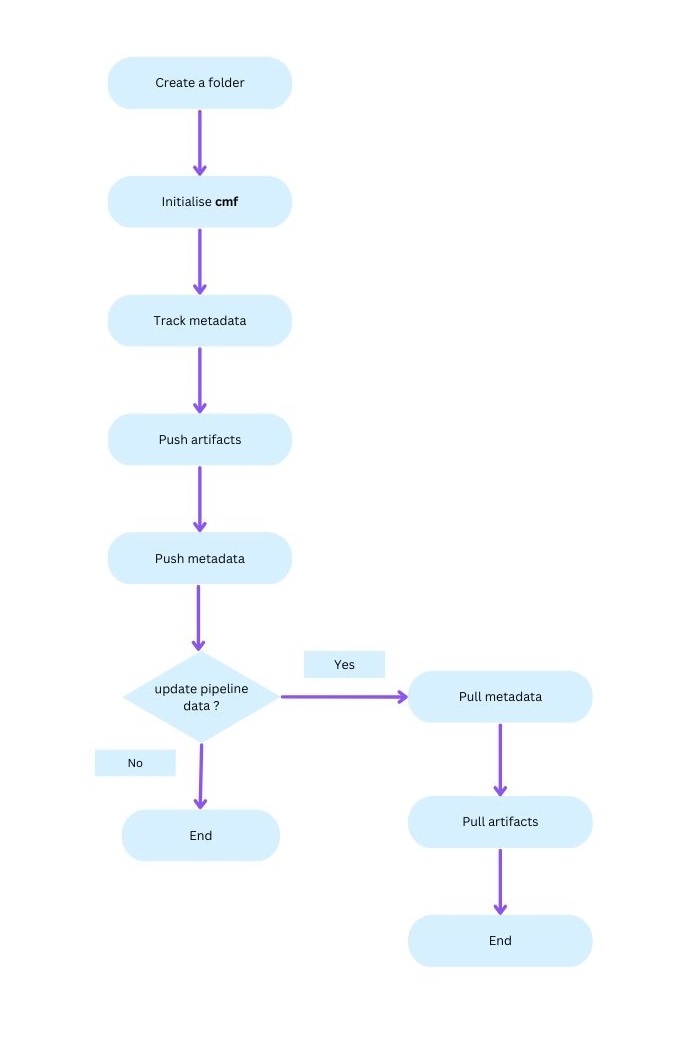Quick start with cmf-client¶
Common metadata framework (cmf) has the following components:
- Metadata Library: exposes APIs for tracking pipeline metadata and provides endpoints to query stored metadata.
- cmf-client: handles metadata exchange with the CMF server, pushes and pulls artifacts from the artifact repository, and syncs code to and from GitHub.
- cmf-server: interacts with all the remote clients and is responsible for merging the metadata transferred by the
cmf-clientand managing the consolidated metadata. - Central Artifact Repositories: host the code and data.
Install cmf library i.e. cmflib¶
Before proceeding, ensure that the CMF library is installed on your system. If not, follow the installation instructions provided in the Installation & Setup page.
Install cmf-server¶
cmf-server is a key interface for the user to explore and track their ML training runs. It allows users to store the metadata file on the cmf-server. The user can retrieve the saved metadata file and can view the content of the saved metadata file using the UI provided by the cmf-server.
Follow the instructions on the Installation & Setup page for details on how to setup a cmf-server.
Setup a cmf-client¶
cmf-client is a command-line tool that facilitates metadata collaboration between different teams or two team members. It allows users to pull or push metadata from or to the cmf-server.
Follow the below-mentioned steps for the end-to-end setup of cmf-client:-
Configuration
- Create working directory
mkdir <workdir> - Execute
cmf initto configure the Data Version Control (DVC) remote directory, Git remote URL, CMF server, and Neo4j. Follow the Getting started with cmf-client commands page for more details.
How to effectively use cmf-client?¶
Let's assume we are tracking the metadata for a pipeline named Test-env with a MinIO S3 bucket as the artifact repository and a cmf-server.
Create a folder
mkdir example-folder
Initialize cmf¶
CMF initialization is the first and foremost step to use cmf-client commands. This command, in one go, completes the initialization process, making cmf-client user friendly. Execute cmf init in the example-folder directory created in the above step.
cmf init minioS3 --url s3://dvc-art --endpoint-url http://x.x.x.x:9000 --access-key-id minioadmin --secret-key minioadmin --git-remote-url https://github.com/user/experiment-repo.git --cmf-server-url http://x.x.x.x:8080 --neo4j-user neo4j --neo4j-password password --neo4j-uri bolt://localhost:7687
Here, "dvc-art" is provided as an example bucket name. However, users can change it as needed. If the user chooses to change it, they will need to update the Dockerfile for minioS3 accordingly.
Check Getting started with cmf-client commands page for more details.
Check status of CMF initialization (Optional)
cmf init show
Track metadata using cmflib
Use Sample projects as a reference to create a new project to track metadata for ML pipelines.
More information is available inside Getting Started.
Before pushing artifacts or metadata, ensure that the cmf server and minioS3 are up and running.
Push artifacts
Push artifacts in the artifact repo initialized in the Initialize cmf step.
cmf artifact push -p 'Test-env'
Push metadata to cmf-server
cmf metadata push -p 'Test-env'
cmf-client with collaborative development¶
In the case of collaborative development, in addition to the above commands, users can follow the commands below to pull metadata and artifacts from a common cmf server and a central artifact repository.
Pull metadata from the server
Execute cmf metadata command in the example_folder.
cmf metadata pull -p 'Test-env'
Pull artifacts from the central artifact repo
Execute cmf artifact command in the example_folder.
cmf artifact pull -p 'Test-env'
Flow Chart for cmf¶
